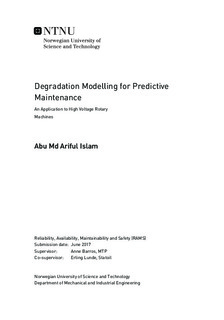Degradation Modelling for Predictive Maintenance - An Application to High Voltage Rotary Machines
Master thesis
Permanent lenke
http://hdl.handle.net/11250/2454358Utgivelsesdato
2017Metadata
Vis full innførselSamlinger
Sammendrag
Large high voltage rotary machines are commonly utilized in gas processing plants for operationssuch as dewatering and compression. The availability of these machines are verycritical as the operation down times are generally associated with expensive productionloss. Therefore this is no surprise that industries put a lot of effort in ensuring the maximumavailability of these machines. However accurate failure prediction of such machinesis challenging due to the complexity associated with technicality, data collection, testingand condition monitoring, etc.This project addresses such an issue regarding the high voltage motors in Kollsnes gasprocessing plant that are currently in operation. It is operated by Gassco and Statoil servesas technical service provider. Karsten Moholt AS conducts the condition monitoring andABB conducts the assessment of the conditions of these motors and claims to predict timeto failure of an individual machine with certain confidence level. However, this predictionmethod is under the copyright of ABB and how the process works is not known by anyother party. Therefore it leaves some room for further investigations regarding estimationof remaining useful life and in addition the current prognostics practice is limited to unitlevel.In this situation, Statoil is interested in estimating remaining useful life of the motorsdue to ageing in order to reduce uncertainty regarding operation outage and to supportoverall maintenance decisions. They are further interested in extending the boundary ofunit level prognostic to system level prognostic because the demand for motor operationvaries depending on the two seasonal periods- summer and winter. In addition, they wouldlike to explore the possibility of developing a simulator that is capable of estimate remaininguseful life of a motor (or possibly the system) under given current health condition,previous history and future probable usage profile of the machine in order to further facilitatemaintenance decision making process.Various approaches have been taken by researchers to address the issues in high voltagerotary machine prognostic but there are still remaining many challenges that are makingthe whole prognostic process complicated. The main focus of this thesis is to develop adegradation model for the rotary machines in order to estimate remaining useful life underthe given current health condition and make a possible transition from unit level prognosticto system level prognostic. The required preliminary task of prognostic estimation involvesfinding a good indicator that describes the health condition of a motor reasonably well.During the process, it s been observed that, failure due to ageing process in stator windinginsulation is the most critical failure mechanism in high voltage rotary machines andthe health of a motor basically depends on the condition of the stator winding insulation.It s been noticed that, ageing processes can be influenced by multiple stresses acting insynergistic fashion which makes any sort of life modeling or degradation modeling verydifficult. It s been further noticed that regardless of the stress acting most dominantly on afailure process, the final failure usually occurs due to electrical ageing. Further progress inthe study leads to the conclusion that, partial discharge test is currently the most acceptable testing method for health condition indication of an insulation system among the availablemethods.Under the assumption that condition monitoring data is available, statistical approachbased on non-homogeneous Gamma process has been employed for the degradation modelingin order to estimate remaining useful life of a given rotary machine. Importantproperties of Gamma process has been discussed in correlation with the rotary machineprognostic. Associated parameters have been calculated with a 95% confidence interval.Quality of parameter estimation has been discussed for several inspection strategies. Incase of prognostic, current condition (actual degradation level) has been incorporated withremaining useful life estimation. This is due to the fact that, condition-based prognostictends to be more accurate than traditional age-based prediction. Some relevant insightshave been discussed and a demonstration have been provided regarding possible transitionfrom unit level prognostic to system level prognostic.Based on expert opinion provided by Statoil and literature surveys, non-homogeneousGamma process appears to be the most appropriate for degradation modeling of windinginsulation system utilizing partial discharge information. However reminding of thefamous quote by George E. P. Box, All models are wrong but some are useful ; proposedmodel requires to go through some validation process with the help of useful fielddata. Nevertheless the proposed model is full of possibilities for making transition froma theoretical model to a more practical model as more information becomes available. Inaddition, application of such degradation modeling is not only limited to this specific case.Gamma process is already a popular choice for this purpose and non-homogeneous gammaprocess have significant implications for civil engineering applications.This thesis proposes an initial framework for prognostics of remaining useful life ofhigh voltage rotary machines under the assumption of non-linear degradation increment ofinsulation system. It shows potential for further research leading to some interesting anduseful outcomes in this particular area of research.
